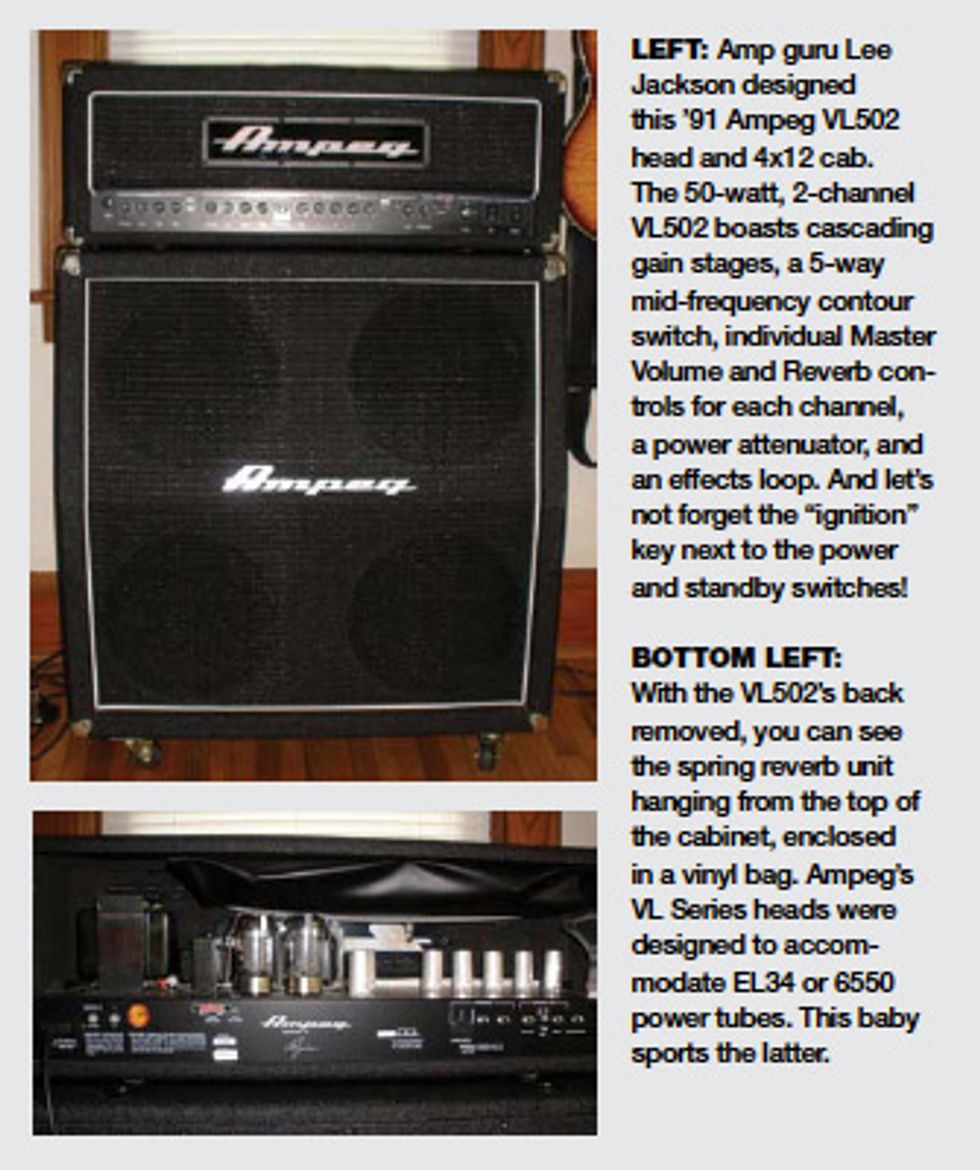Hey Zach,
I recently acquired a late-’80s or early-’90s Ampeg VL502 amp
with a matching SS412AS 4x12 cab. The amp’s serial number
is L52DDB0094. The original owner hardly used it, and the rig
spent most of its life in his basement. It’s in excellent condition
and still has the original tubes. While I vaguely remember these
first coming out, info on them seems pretty scarce. What I do
know is this rig sounds great—in a “modified Marshall” kind of
way. What can you tell me about this Ampeg?
Thanks,
—Mike in Austin, MN

Hey Mike,
Cool amp—I sure don’t see many of these anymore! The Ampeg VL502, along with all the amps in the VL Series, was designed by amp guru Lee Jackson. Jackson established himself as an amp modifier in Los Angeles during the 1980s, specifically with Marshalls. Jackson worked as a designer for several companies, including B.C. Rich, Fender, Pignose, Metaltronix, Harmony, and, of course, Ampeg. He is probably best known for his XLA-1000 amp, a direct copy of the amps he built for Zakk Wylde, Steve Vai, and George Lynch. Currently, Jackson produces amps and effects under his own name in Austin, Texas.
In 1986, St. Louis Music (SLM) bought Ampeg out of bankruptcy, acquiring two truckloads of various items and parts. SLM resumed production, first reviving the SVT line, and then followed with a line of guitar and bass amps generally based on established Ampeg designs. Ampeg was a very traditional company during the ’60s and ’70s, and Everett Hull (Ampeg’s owner at that time) despised rock ’n’ roll music. Ampeg’s artist relations department indicated that since music was changing in the late ’80s and early ’90s, a musician’s needs had to be met in order for Ampeg to make a profit. The R&D department hired Lee Jackson in the fall of 1990 to design a line of guitar amplifiers that became the VL series. These new amps were released in 1991 and utilized several features never before seen on an Ampeg.
The VL Series included a single-channel model available in 50-watt (VL501) and 100- watt (VL1001) versions, and a 2-channel model with reverb in 50-watt (VL502) and 100-watt (VL1002) versions. The massive 3-channel VL503 was later introduced in 1993. All were heads, and they could run either 6550 or EL34 power tubes with a bias switch to properly adjust them. They also included a built-in attenuator, cascading gain stages, a 5-way mid-frequency contour switch, and an effects loop. The 2-channel amps also had separate Master Volume and Reverb controls. Maybe the coolest feature was a lock-and-key system to prevent unauthorized use!
Speaker cabinets were available in a 2x12 configuration with Celestion G12K-85 speakers, as well as 4x12 configurations with Celestion Vintage 30s, Celestion G12T-75s, or Ampeg Customs. I remember these amps being very heavy. The VL Series didn’t stand for anything in particular, though some users joke that it stood for very loud.
Innovation is usually what drives the guitar industry, but unfortunately the VL Series (along with many of Ampeg’s other new designs at the time) was relatively short-lived. The single-channel VL501 only lasted through 1992, and the VL1001 was produced through 1993. The 2-channel reverb VL502 and VL1002, along with the 3-channel VL503, were manufactured until 1995. A product’s successfulness can generally be gauged on life span, so the VL Series wasn’t received very well (production numbers were unavailable for the series).
Since Ampeg had been such a traditional and conservative company for so long, many musicians were simply used to that. Why would a guitarist buy a relatively unknown Ampeg VL when companies like Marshall and Mesa/Boogie had established themselves as the builders of high-gain amps? I’d guess that sales records would answer that question. Since the mid ’90s, Ampeg has returned to its roots, mainly offering guitar and bass amps based on the company’s vintage designs that produce clean, full tones.
Based on the serial number, your VL502 was built in December of 1991, and it’s worth between $400-$500 today. However, these amps have earned an almost cultish status over the years because of the association with Lee Jackson. It’s not surprising that your VL502 sounds like a modded Marshall at times, since that’s how Jackson made his reputation. For a US-made tube amp that produces all the tones you need, this amp is definitely a treasure!
 Zachary R. Fjestad
is author of Blue Book of
Acoustic Guitars, Blue Book
of Electric Guitars, and Blue
Book of Guitar Amplifiers.
For more information, visit
bluebookinc.com or email
Zach at guitars@bluebookinc.com.
Zachary R. Fjestad
is author of Blue Book of
Acoustic Guitars, Blue Book
of Electric Guitars, and Blue
Book of Guitar Amplifiers.
For more information, visit
bluebookinc.com or email
Zach at guitars@bluebookinc.com.








![Rig Rundown: Russian Circles’ Mike Sullivan [2025]](https://www.premierguitar.com/media-library/youtube.jpg?id=62303631&width=1245&height=700&quality=70&coordinates=0%2C0%2C0%2C0)








